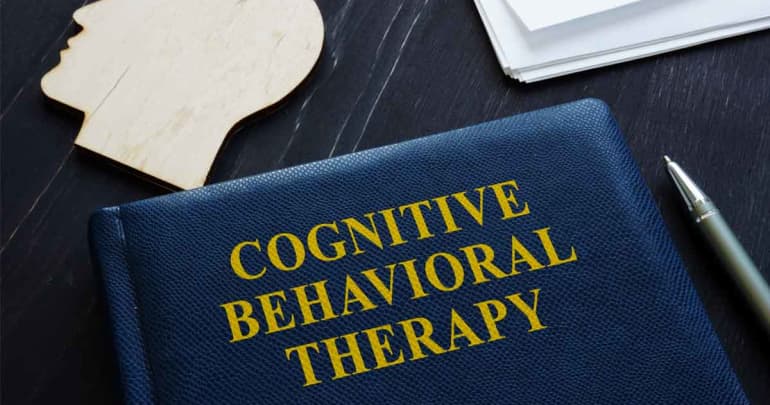Therapy is a cornerstone of all most (if not all) drug treatment programs. While there are many types of individual and group therapy, Cognitive Behavioral Therapy (CBT) is one of the most common and effective therapies available to newly recovering addicts. If you are not familiar with CBT, this article will introduce you to this popular therapy.
The basic concept of cognitive-behavioral therapy (CBT) is that our perceptions are far more impactful to how we process our responses than the reality of the experience itself. Our interpretations, responses, thoughts, and emotions directly affect, on a profound level, how we approach, react, and handle the events of our lives. Over time we become conditioned to respond to our experiences in a habitual way.
CBT helps patients re-educate themselves through a variety of techniques that help change habitual ways of thinking, feeling, perceiving, and reacting to events. In this way, people learn to replace distorted or false thinking with a more realistic (and frequently accurate) approach.
Research into cognitive processes which involve our belief systems, (i.e. recurrent thoughts, assumptions, fantasies, etc.) revealed how these processes play an essential role in mental, emotional, and substance abuse disorders. It showed that people have the potential to control their response to their environment to a large extent.
CBT is collaborative and goal-oriented. The patient and therapist consider and decide together on the appropriate treatment goals, the type and timing of skills training, the nature of outside practice tasks, and so on. Not only does this foster the development of a good working relationship and avoid an overly passive stance by the therapist, but it also assures that treatment will be most useful and relevant to the patient.
What Exactly is Cognitive Behavioral Therapy?
In its simplest definition, CBT is a form of psychotherapy that looks to change the negative patterns of thinking and behavior that are the underlying roots of a person’s substance abuse. Cognitive Behavioral Therapy is seen as a combination of both psychotherapy and behavioral therapy. This popular therapy explores the progression of attitudes and behavior from childhood to the present day.

In particular, CBT focuses on an individual’s negative thoughts and feelings. It is believed the energy given to negative thoughts distorts their thinking. As a result, people cannot see ways how they can change those behaviors. Negative thoughts that may have developed in childhood become automatic and fixed. When people experience failure in their daily lives, they feel they are a failure as a whole person and there is no way to correct the situation.
What comes to mind when someone tells you they’re going to therapy? Most people think of someone sitting with a certified professional to talk about their problems. While it’s a very basic description of the process, the idea that comes to mind when people think of therapy roughly describes cognitive behavioral therapy.
Cognitive behavioral therapy is a therapy modality used to treat a wide range of psychiatric conditions. It’s a simple but effective method used to treat a wide range of people struggling with problems from marital issues to depression to addiction.
There are no frills or gimmicks when using cognitive behavioral therapy. It is a straightforward talk therapy approach that helps millions of people every year. Therapists commonly start with this method while assessing a new client since it’s useful for such a variety of conditions.
What Does Cognitive Behavioral Therapy Mean?
Cognitive-behavioral therapy also referred to as CBT for short, is a therapeutic treatment approach. It aims to help many different types of people through a variety of problems in life. CBT focuses on the relationship between the way a client interprets the world around them and their resulting behaviors.

It is a problem-based and goal-focused method of treatment. A client comes in with a specific problem in mind and their therapist helps them create some long-term treatment goals. The client’s goals depend on the problems they come to therapy with. For example, CBT can help a client reduce stress, improve self-confidence, manage their relationships, or cope with grief.
In order to achieve these goals, cognitive behavioral therapy operates on a few basic ideas:
- Unhelpful or incorrect thoughts and beliefs contribute to psychological distress.
- Unhelpful or unhealthy behaviors result from these thoughts and beliefs.
- People experiencing psychological distress and unhealthy behaviors can adjust their thought patterns and behaviors through treatment, leading to a more effective life.
Basically, CBT works on how a client thinks about and interprets life in order to affect how they feel and behave. The ultimate goal of treatment is to teach a person to become their own therapist. This empowers them so they can walk through similar situations they may face in the future.
When Was Cognitive Behavioral Therapy Developed?
Prior to the introduction of cognitive behavioral therapy, psychoanalysis was a common method of treatment. Psychoanalysis looked at subconscious thought and how it impacted the way people approached their lives.
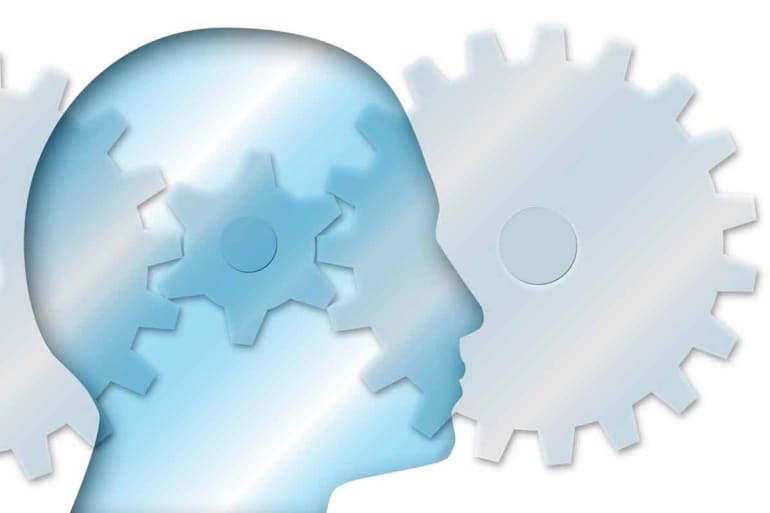
Then behavior therapy emerged in the 1950s as one of the first methods to look at the causes of human behavior. Psychiatrists wanted a way to help their clients lead more effective daily lives and behavior therapy was a step in the right direction.
Cognitive behavioral therapy was introduced in the 1960s as an enhanced form of behavior therapy. Rather than looking at environmental factors as the main influence on actions, CBT encouraged psychiatrists to look inward at their clients’ thoughts.
Who is the Founder of Cognitive Behavioral Therapy?
Psychiatrist Aaron Beck pioneered the cognitive behavioral therapy movement.
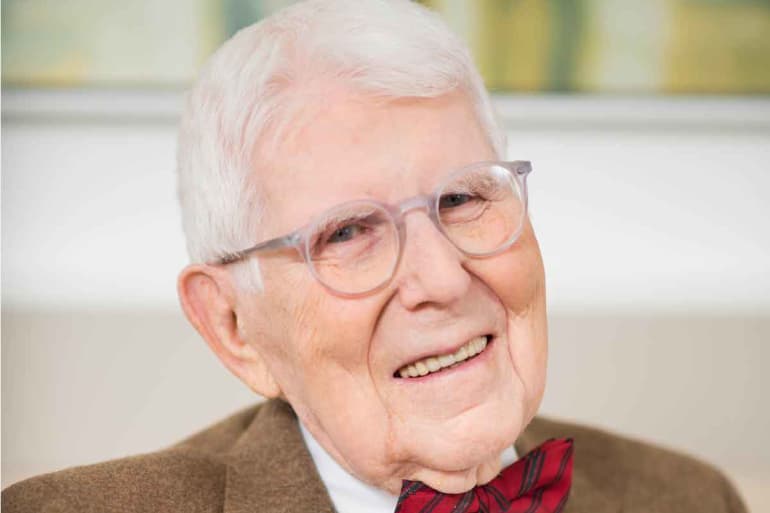
Prior to creating CBT, he used psychoanalysis to work with most of his clients. During his sessions, he realized the extent and influence of the inner dialogue running through his clients’ minds. These automatic thoughts, as he called them, seemed to influence every area of their lives.
Beck acknowledged that people aren’t often aware of how much these automatic thoughts affect their behavior. They usually don’t even notice the number of thoughts that run through their head in a given period of time. If they aren’t aware of these automatic thoughts, they aren’t aware of how those thoughts influence their feelings and decisions.
He encouraged his clients to look at and identify the thoughts that crossed their minds. More often than not, their negative feelings and behaviors resulted from negative thoughts or beliefs. He worked with clients to reframe their mindsets and adjust these unhelpful thinking and belief patterns. As they worked through these cognitions, clients’ behavior improved.
The Components of Cognitive Behavioral Therapy
There are four essential components that guide CBT sessions. First, the therapist and client work together to pinpoint the sources of negative thinking and behaviors. This is done through a thorough evaluation of a client’s daily life, social interactions, and how they handle stress. Once identified, the therapist will focus on those specific negative beliefs that led to the formation of these emotions. When those beliefs are uncovered, the therapist and client work to build strategies to replace negative self-talk into positive assertions.
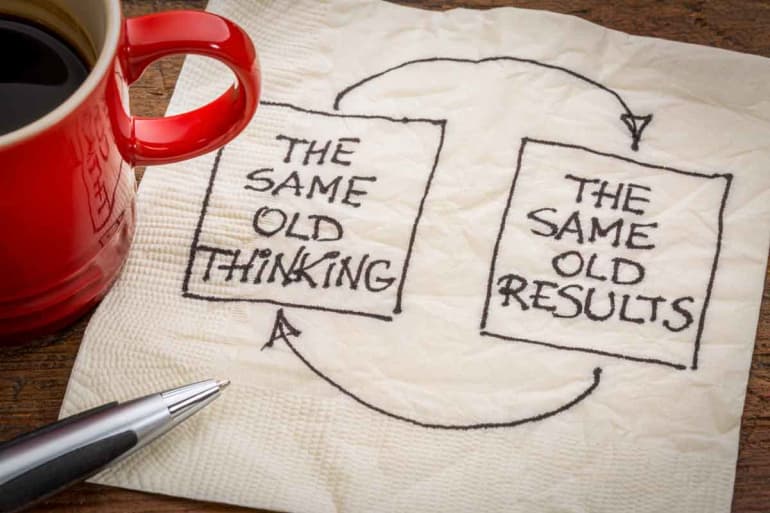
Working together, both therapist and client find ways to reframing negative emotions, thoughts and beliefs to a healthy mindset where the client can be proactive. In this phase of therapy, clients are encouraged to journal and write down positive self-talk responses when they encounter difficult, stressful situations. Finally, the therapist will help the client set goals and solutions to help them better manage stress and anxiety. These tools including continued journaling, meditation, exercise or finding a healthy hobby or other pastime.
How is Cognitive Behavioral Therapy Session Structured?
At the beginning of a CBT session, the therapist will administer a variety of assessment tools to assess the client’s current mood along with how they are doing that day. In each session, the therapist will ask the client if they have a specific problem they would like to focus on for that session. The therapist and client will look at the issue at end in greater detail. Both parties will problem-solve and evaluate the accuracy of the client’s thoughts and behaviors in dealing with that particular issue.

When this collaborative assessment is completed, the therapist will help the client develop and put into practice positive thought patterns and coping skills so they can deal with their problem or problems in a healthier manner. At the end of each session, both therapist and client will discuss ways to best use the skills they learned going forward to the next session. The client will be asked to critique the session and tell the therapist what was helpful and what needs further clarification or improvement.
The Benefits of Cognitive Behavior Therapy
The biggest benefit of CBT is that both the therapist and client work together to determine how long therapy is needed. The therapist usually has a strong idea of how long therapy will be needed to tackle a client’s issues within the first couple of sessions. On average, cognitive behavioral therapy can from 6 to 8 sessions—provided the client does their due diligence.
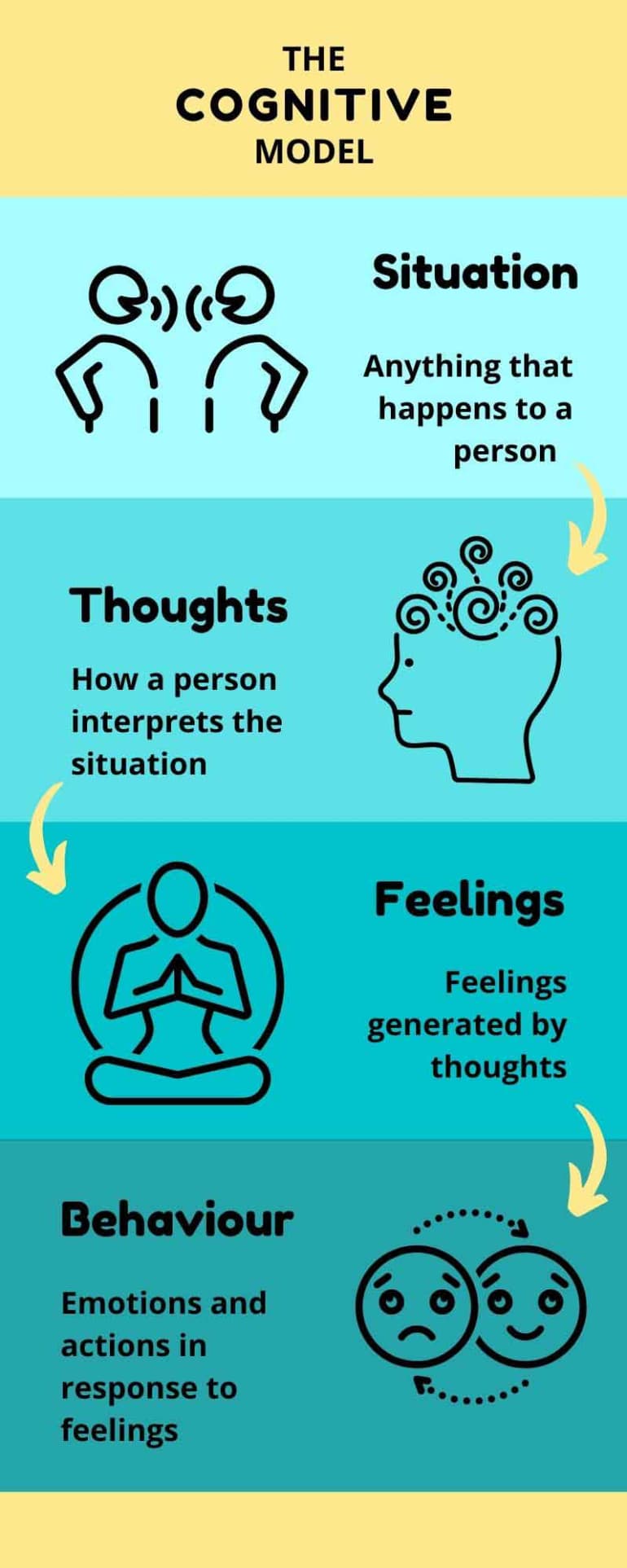
While therapy can be relatively short in duration, there is no set time limit regarding the number or frequency of CBT sessions. The patient can attend any many sessions they feel are needed, and the frequency of sessions are gradually tapered as the client improves. People who undergo CBT are encouraged to pursue booster sessions at three, six and 12 months.

To learn about substance abuse and how our treatment programs in Hawaii can help with ADHD and co-occurring disorders.
More infoBasic Principles of CBT
Learned Behavior
CBT is based on social learning theory. It is assumed that an important factor in how individuals begin to use and abuse substances is that they learn to do so. The several ways individuals may learn to use drugs include modeling, operant conditioning, and classical conditioning.
Modeling
People learn new skills by watching others and then trying it themselves. For example, children learn language by listening to and copying their parents. The same may be true for many substance abusers. By seeing their parents use alcohol, individuals may learn to cope with problems by drinking. Teenagers often begin smoking after watching their friends use cigarettes.
Operant Conditioning
Laboratory animals will work to obtain the same substances that many humans abuse (cocaine, opiates, and alcohol) because they find exposure to the substance pleasurable, that is, reinforcing.
Classical Conditioning
Pavlov demonstrated that, over time, repeated pairings of one stimulus (e.g., a bell ringing) with another (e.g., the presentation of food) could elicit a reliable response (e.g., a dog salivating). Over time, substance abuse may become paired with particular places (bars, places to buy drugs), particular people (drug-using associates, dealers), times of day or week (after work, weekends), emotional states (lonely, bored), and so on. Eventually, exposure to those cues alone is sufficient to elicit very intense cravings or urges that are often followed by abuse.
Cognitive behavior therapy is a crucial component of drug treatment programs. If you or a loved one is seeking treatment, CBT is a must. If you want to learn more about CBT and how it can help you or a loved one, call Hawaii Island Recovery today. Our compassionate and experienced treatment staff will explain the benefits of cognitive behavioral therapy and how it can be a big part of your individual treatment plan.
What is Cognitive Behavioral Therapy Used For?
There’s a reason cognitive behavioral therapy is one of the most-used forms of therapy today. It’s an effective method and CBT works when treating a wide variety of cases, from situational to severe. It is a solution-focused treatment modality that finds a specific problem then aims to solve it.
Rather than dwelling on childhood memories for session after session, CBT identifies a current issue and faces it head-on. The therapist and client work through the client’s negative thought patterns that result in their undesired behavior. By adjusting these beliefs in a more positive direction, the client finds that positive actions follow as a result.
The ultimate goal of CBT is to equip people with the ability to counsel themselves at the end of treatment. They don’t want a client seeking the intervention of a therapist each time a problem arises. Therapists want to equip their clients with the ability to work through the roadblocks that come up in life on their own.
Teaching a person to be their own therapist empowers them which also results in more positive thought patterns. When used correctly, it’s a method that follows an upward trajectory that unshackles a client from months or years of unhealthy thought patterns.
When is Cognitive Behavioral Therapy Used?
Cognitive-behavioral therapy isn’t intended for one single type of situation or mental illness. It’s a practical treatment method capable of helping any number of cases seeking therapy.

Therapists might opt for a CBT method with two very different people who would still benefit from the same approach.
People with a situational problem, such as the loss of a job or difficulties in a relationship, find solutions through CBT. At the same time, a therapist might find that someone with severe depression or anxiety also responds well to CBT. Every individual is different but the therapy method’s universal approach can work for seemingly unrelated cases.
Cognitive behavioral therapy is used for the conditions above, as well as
cases including:
- Obsessive-compulsive disorder
- Eating disorders
- Drug and alcohol use problems
- Marital problems
- Chronic pain
- Tinnitus
- Rheumatism
What Are the Different Types Of Cognitive Behavioral Therapy?
Today, CBT has become more of an umbrella term to describe both general cognitive behavioral therapy and some additional sub-sections. It still functions as its own approach to therapy but there are a few specialized methods that fall within the category.
Again, cognitive behavioral therapy focuses on the relationship between thoughts and their resulting behaviors. These approaches are related by their emphasis on current problems and setting concrete goals to solve them.
Cognitive Processing Therapy
Cognitive processing therapy, or CPT, is a type of cognitive behavioral therapy focused on treating PTSD. Often people who experience trauma develop unhealthy or harmful beliefs about themselves, other people, and the world. CPT challenges these automatic thoughts that affect a client’s life today. Addressing these thoughts helps relieve the impact of that event.
Dialectical Behavior Therapy
Dialectical behavior therapy, or DBT, is similar to CBT but initially adjusted to treat borderline personality disorder. Clients with BPD tend to live in a state of high emotional arousal, leading to chaotic behaviors that have a severe impact on their relationships. DBT focuses and works on the way that both the client’s thoughts and behaviors affect their interactions with others.
Rational Emotive Behavior Therapy
Rational emotive behavior therapy, or REBT, helps clients identify self-deprecative thoughts and feelings. These lead to negative emotions, like extreme anger, guilt, depression, or anxiety, that result in negative behaviors. Therapists using REBT work with a client to uncover and alter their thought patterns that cause this negative feedback loop.
What Are Cognitive Behavioral Therapy Techniques?
When many people think of therapy, they often picture sitting on a couch and delving deep into their past. Some think that therapy or counseling is all about uncovering your childhood to find out why you are the way you are.
Some therapy modalities use this practice. Therapists using these methods ask clients to think back as far as they can to their earliest memories. They uncover these formative childhood years to create a roadmap of the person’s present-day personality.
Although there is a time and a place for this type of therapy, that isn’t the only way CBT approaches treatment. Cognitive behavioral therapy chooses to focus more on the way a client’s current thoughts and beliefs affect their behavior.
Some of those might stem from the past but therapists don’t always take a deep dive into their sources. Instead, they focus on how to reframe those beliefs with present-day solutions. It combines the analysis of psychotherapy with problems, thoughts, and behavior focus of behavior therapy.
CBT is a short-term method, meaning the goal is to wrap up treatment within a few months to a year. Its action- and solution-oriented approach makes it possible for clients to move through therapy at a steady pace.
What Does Cognitive Behavioral Therapy Treat?
The versatile nature of cognitive-behavioral therapy makes it useful in treating a wide range of cases. It’s an open-ended, problem-focused approach. There is no set of conditions that dictates what the problem must be.

Instead, it gives therapists and their clients the opportunity to assess problematic behaviors. Together, they can seek out things a client does that negatively impacts their life. Once they select a target behavior, they can uncover the harmful thoughts and beliefs that encourage that behavior.
Therapist helps their client challenge and reform their negative feelings and beliefs about themselves during sessions. After a few months of work and practice, the client should notice a shift in their once-problematic behavior.
It equips every case with the coping mechanisms that help them challenge their negative thought patterns. Then, over time, they learn to break their cyclical thoughts without requiring the intervention of their therapist.
CBT helps numerous cases and conditions, whether it’s someone struggling in their marriage or a person with crippling anxiety. People with alcohol and drug problems or other mental illnesses benefit from cognitive behavioral therapy as well.
CBT for Alcohol Abuse
There tend to be deeper issues under the surface of someone who abuses alcohol. Heavy drinkers usually drink for a reason, whether it’s to escape the situation they’re in or the things their mind tells them.
Alcohol addiction is a serious problem that often affects multiple aspects of a drinker’s life. They experience consequences for their drinking in numerous areas. Perhaps they lose their job or the support of their friends and family. These consequences lead to more negative beliefs that cause them to drink more.
CBT for alcohol abuse encourages a person to look at the thoughts that cause them to drink in the first place. In the face of the destruction that their drinking causes, what negative beliefs or ideas make them take another drink?
Therapists can help those who abuse alcohol uncover the faulty thought patterns that lead them back to alcohol time after time. The goal of CBT is to address those thoughts and equip a person with alternative coping mechanisms that don’t include drinking.
CBT for Drug Addiction
Drug addiction becomes a deadlier problem with each passing year. As stronger drugs make their way into the hands of addicts across the country, there is a serious need for a solution. CBT for drug addiction is one solution that puts a dent in the alarming addiction rates.
Much like alcohol abuse, drug addiction doesn’t happen without a reason. People who turn to drugs are often looking for a way to escape from something, whether it’s their head or their surroundings. Drugs become a coping mechanism that gets them away from whatever it is they need to run from.
After turning to drugs as a way to cope for a few months or multiple years, it becomes a habit. The cycle of addiction grabs hold of the person and they find it difficult or seemingly impossible to get out of it. Substances become the center of their lives because they become the go-to method to getaway.
CBT for drug addiction is one step in the process of treating substance use disorder. Together with a therapist, the recovering addict will identify their thought patterns that lead up to using. They work through pain points and harmful ideas in order to develop new coping skills that don’t involve any type of substance.
CBT for Depression
Two characteristic traits of depression are the negative talk and false beliefs a person holds about themselves. It isn’t always clear why someone struggles with depression, especially when things seem fine. But their internal monologue tells them a completely different story than what you might see from the outside looking in.
CBT for depression deals with those harmful thought patterns. People with mild or moderate situational depression might even see results with cognitive behavioral therapy alone. They might not need the assistance of medication if they respond well to a therapeutic approach.
A therapist will walk a client with depression through identifying and challenging their negative thoughts. These might include their skewed perception of themselves, their surroundings, or the world at large. Reframing these thoughts can relieve or remove the symptoms of depression and return the person back to their normal life.
CBT for PTSD
Post-traumatic stress disorder is a serious condition that often requires intensive therapy. It describes a mental condition seen in people who experienced a traumatic event. Their brain never processed the trauma properly and they still live with heightened responses to their surroundings.
Individuals with PTSD tend to carry negative beliefs about themselves as a result of the event. They may try to take responsibility or blame themselves for what happened. If they don’t receive help for months or years afterward, these beliefs become deeply ingrained.
Therapists can help these individuals who carry shame and guilt surrounding their trauma and resulting condition. People who struggle with PTSD are not weak-willed; they need help healing the symptoms that resulted from an extreme event.
CBT for PTSD can relieve the heightened emotional responses and flashbacks resulting from the event. People with PTSD often find relief from their symptoms through the intervention of a cognitive behavioral therapy treatment plan.
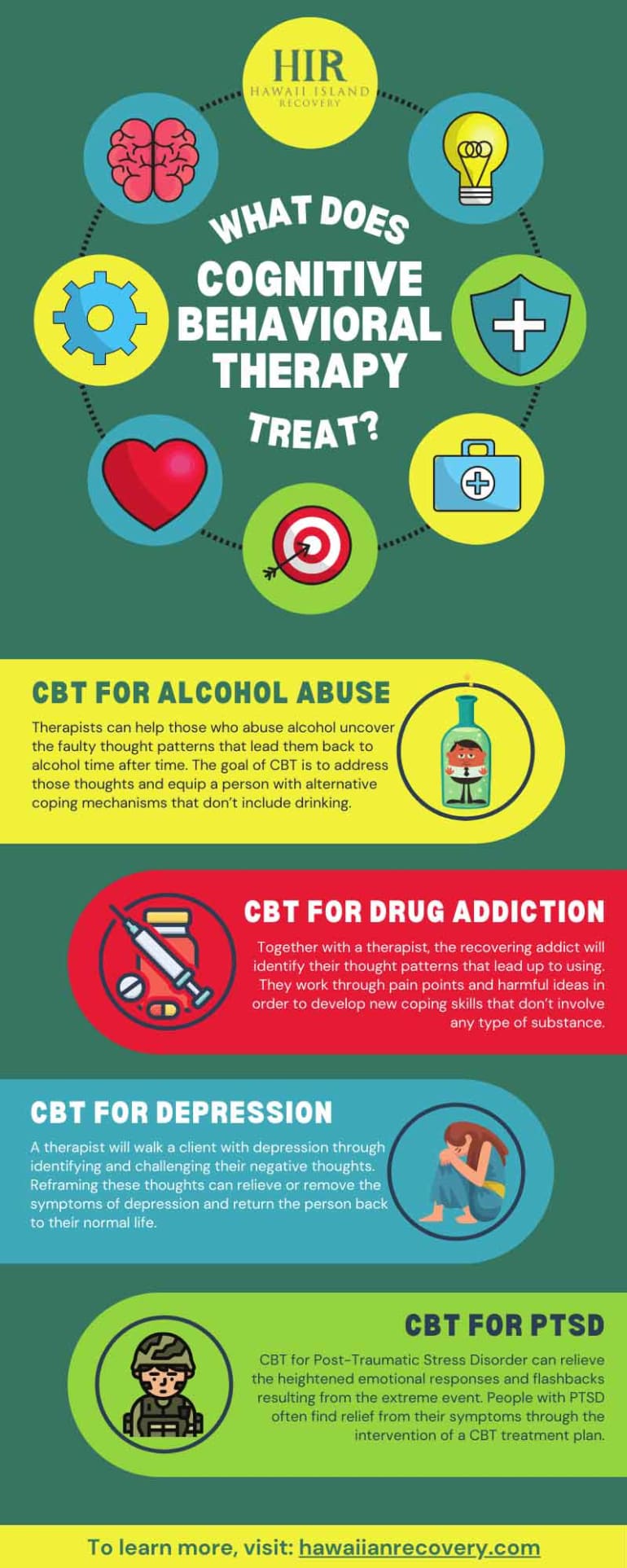
How Cognitive Behavioral Therapy Works
Cognitive-behavioral therapy works with the idea that a person’s thoughts affect their behavior. If they have negative, critical, self-deprecating thoughts, they will likely have negative behaviors as a result. These behaviors range from having a disagreeable attitude to depression and anxiety to drug and alcohol abuse.

At its most basic, the idea is that distorted perception of the world causes a disordered response to it. Someone who thinks poorly about themselves and the world around them behaves poorly as a result. On the other hand, someone who thinks mostly positively about themselves and their surroundings will behave positively.
A therapist using CBT with a client aims to remove their negative behaviors by helping them adjust their negative thought patterns. This helps clients with numerous issues from situational difficulties, like job loss counseling, to serious mental illnesses. The adaptable approach of CBGT makes it a helpful option for many.
The Components of Cognitive Behavioral Therapy
Cognitive-behavioral therapy is broken down into two main components: functional analysis and skills training. They are important parts of any treatment program using CBT because they help guide the course of the sessions.
Functional Analysis
The functional analysis component describes the process of a therapist and their client assessing any existing high-risk behaviors. They look over repetitive issues and themes in the client’s life. Once they find reoccurring situations where the client has a difficult time coping, they look at the underlying causes. These include triggers and feelings that lead to a negative outcome.
Skills Training
Skills training comes into play after therapists and their clients uncover the feelings and beliefs that cause negative outcomes. The therapist now works with their client to adjust the thought patterns that lead to these feelings. Then they work on developing necessary coping skills to help regulate their emotional responses.
Basic Principles of CBT
The various subsets of CBT are all joined by some basic principles. Each off-shoot holds the same basic understanding of how to run an effective cognitive behavioral therapy session.
Brief and Time Limited
One goal of CBT is to ensure treatment takes place in a timely manner. Therapists and their clients set out from the beginning of treatment with set a timeframe in mind. It’s not a drawn-out, ongoing form of therapy. Usually, treatment takes place during the course of 16 sessions.
Present Centered
Cognitive-behavioral therapy focuses mostly on the present moment. It doesn’t delve much into past history or childhood memories. Instead, it places emphasis on current beliefs that affect present-day behavior. Keeping the focus current is part of what makes CBT an efficient form of treatment.
Thought Focused
CBT operates under the main understanding that thoughts lead to behaviors. Therefore, CBT emphasizes the importance of recognizing unhelpful or irrational thoughts and beliefs. Changing these thoughts results in changed behavior.
Practice and Homework
An integral aspect of therapy is the at-home aspect. Clients can’t receive all the help they need in only one or two hours per week. More important than the in-session work is the at-home work. Therapists give their clients small homework assignments that encourage them to practice what they learn during their sessions. Then they report back and make any necessary adjustments for the upcoming week.
Dependable Therapeutic Relationships
The most important part of any CBT treatment program is a dependable relationship with the therapist. There will be no progress, no matter how many sessions a client attends, if they don’t trust their therapist. It’s important for a therapist to guide each session in a positive and professional manner, remembering to listen, teach, and encourage their client.
What are the Three Goals of Cognitive Behavioral Therapy?
People seek out therapy with slightly different goals depending on their situation. They might want to fix their marriage or learn how to navigate daily life without intrusive anxiety. No matter their personal goals, though, there are some overarching goals of CBT that tend to link each person together.
Teach Coping Skills
Cognitive-behavioral therapy teaches clients coping skills. Part of the reason they seek out therapy is their inability to cope with their present situation. They have trouble in one way or another with whatever is happening in their life. Therapists using CBT equip their clients with coping skills that help them navigate through the challenges in their life.
Encourage Regulation of Painful Feelings
Everyone experiences painful feelings from time to time. Sometimes these feelings are overwhelming and consuming, making it difficult to focus on anything else. Thankfully, CBT encourages the management and regulation of these painful feelings. Clients learn to sit with difficult emotions rather than act out in a negative way when they don’t feel good.
Improve Interpersonal Relationships and Support Systems
Improving interpersonal relationships and creating a support system is a necessary aspect of CBT. Clients who lack healthy relationships with family and friends have a difficult time navigating life effectively. It will be much harder to heal if they don’t have anyone to support them during their healing process. CBT emphasizes the importance of fostering healthy relationships with a support system.
What is the ABC Model?
Cognitive-behavioral therapy draws from the ABC Model created by Albert Ellis in 1957. His ABC Technique of Irrational Beliefs outlines a three-step way people develop their negative thought patterns.
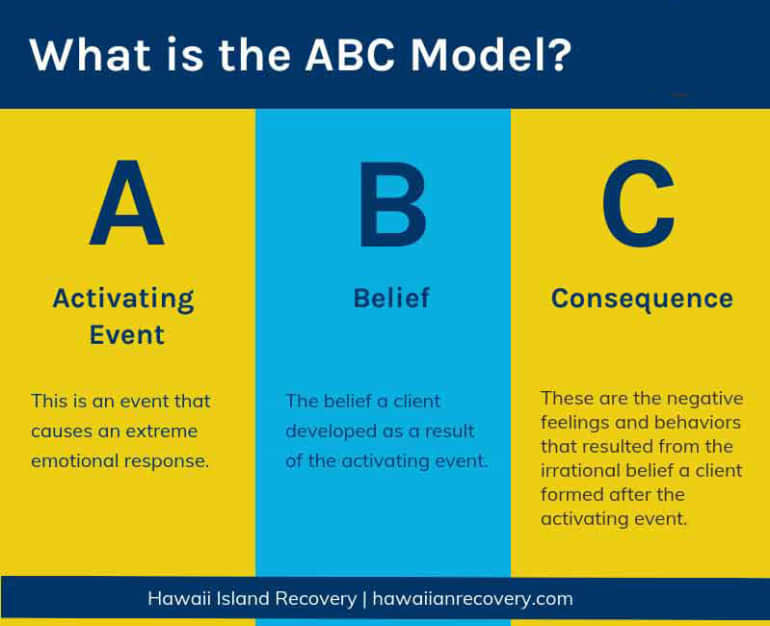
- Activating Event: This is an event that causes an extreme emotional response.
- Belief: The belief a client developed as a result of the activating event.
- Consequence: These are the negative feelings and behaviors that resulted from the irrational belief a client formed after the activating event.
Some people believe that a person jumps directly from the activating event (A) to the consequence (C). But Ellis’s ABC Model emphasizes the importance of the Belief stage in the process. He stressed the unrealistic beliefs people placed on these events as the cause of the ongoing consequences that result.
For example, a negative event can happen to two different people. One person develops a rational belief about the negative event so they experience a healthy negative emotion or consequence. The other person develops an irrational belief about the same event so they experience an unhealthy negative emotion.
These unhealthy negative emotions cause a variety of negative behaviors that CBT then aims to treat.
How Are Cognitive Behavioral Therapy Sessions Structured?
Most cognitive-behavioral therapy sessions are an hour long. Since there is so much to cover during each session, general guidelines encourage breaking each down into three 20-minute intervals. This sets a framework for the session and ensures the therapist keeps their clients on track.

For example, a CBT session for a client struggling with their substance use might resemble something like the following outline:
First 20 minutes
- Discuss any substance use, cravings, or risky situations that took place between sessions
- Address any potential client concerns
- Review the previous week’s practice assignment
Second 20 minutes
- Decide upon and transition into the topic for the session
- Draw connections between the session topic and the client’s
present problems
Third 20 minutes
- Work through any reactions to the current session topic
- Determine a practice exercise for the upcoming week
- Talk through plans for the week and any potential risks that might arise
The therapist’s job is to maintain appropriate pacing and guide their client during the session. They decide when certain topics need more attention or avoid drawing out topics that require less discussion.
How is Cognitive Behavioral Therapy Done?
When a client comes in for their first cognitive behavioral therapy session, the therapist first determines and lays out a plan for treatment. They start with a client assessment to find out why the person chose to seek therapy.
This assessment period is an integral moment in establishing and setting the tone for the client-therapist relationship. Therapists work to foster a sense of trust and understanding in this first hour with their new client. They want to ensure their client feels safe and heard during their first session so they will return and continue with treatment.
Once the therapist has an understanding of the client’s present situation, they look for the client’s motivation to change. Why are they looking for help? What is their reasoning for seeking therapy now and what is on the line? Will something happen if they aren’t able to succeed in changing their behavior?
If CBT is an appropriate choice for treating the client, the therapist introduces the therapy modality and how it works. They work together with their client to establish goals, objectives, and benchmarks for treatment. Then the true work can begin.
How Long Does it Take For Cognitive Behavioral Therapy to Work?
One of the most important aspects of cognitive-behavioral therapy is its time-conscious approach to treatment. It isn’t intended to drag out over years and years; CBT is focused on the present-day and goal-oriented by nature. The client knows their anticipated end date from the time they start treatment.
Most cognitive-behavioral treatment plans include 16 sessions that take place during the course of 12 weeks. There may be more sessions in less time or fewer sessions over a longer period of time. CBT is a flexible form of treatment and can adapt to whatever a client’s needs might be.
Ultimately, therapists try to treat the target issue in a timely manner. They don’t want to prolong therapy unnecessarily regardless of the issue at hand. The therapist’s goal is to teach the client how to be their own therapist. They want to equip clients with coping skills and the capability to regulate their emotions without needing long-term therapy.
As long as therapists keep them on track, the majority of clients can work through their present issues within those 16 sessions. If the end of treatment is approaching, though, and it seems like an extra session might be necessary, their needs can always be accommodated.
The Benefits of Cognitive Behavioral Therapy
Since it offers such a versatile method of treatment, the benefits of cognitive-behavioral therapy are immense. It can be used in different ways to help all kinds of people who come to therapy for a variety of reasons. CBT is one of the few one-size-fits-most approaches to treatment that is available today.

If you want to know whether CBT is for you, you’re wondering what the benefits of cognitive-behavioral therapy are. The specific benefits depend on the problems you come to therapy with. There are also some overall positive effects of CBT seen in the majority of successful treatment cases.
The benefits of cognitive-behavioral therapy include:
1. It provides structured, instructive treatment.
Their therapist guides them through treatment and offers a clear direction. Clients leave each week with an assignment to practice in their daily lives. They learn over time to become their own therapists and won’t need to rely on therapy when similar situations arise.
The CBT method leaves very few things open for questions. Once a therapist and their client decide on an approach, it’s a structured, direct, and instructive form of treatment. That doesn’t mean it is inflexible, though.
2. It’s an adaptable method of therapy.
Although CBT is structured and instructive during treatment, it’s also an adaptable modality. It’s used for a wide range of cases that seek therapy. CBT can help someone struggling with severe depression as much as it can someone who has trouble with their everyday interpersonal relationships.
Therapists can adapt their approach to each client who comes through the door. A therapist can take more time in areas where their client still clearly has work to do. It’s possible to break things up over multiple sessions if it can’t be covered in a single meeting. This blend of structure and adaptability makes it a valuable type of therapy.
3. It is a short-term treatment approach.
Some people hesitate to look for a therapist because they worry they’ll spend years talking with them. Most of the time someone wants a quick fix to their problem and to be on their way. They don’t want to spend hours of their lives sitting in a therapist’s office.
CBT is a time-sensitive treatment method. It aims to educate and equip clients to help themselves as efficiently as possible. Cognitive-behavioral therapy is solution-oriented rather than open-ended. Therapists use every session to guide their clients closer to the resolution of their problems.
4. It focuses on getting better, not just feeling better.
Some treatment approaches focus on the symptoms of a problem rather than the cause of it. When you only treat symptoms, though, the problem still exists and the symptoms will eventually return.
CBT shifts the focus from a person’s symptoms to the cause of those symptoms. It encourages clients to look at the thoughts that guide their lives rather than only the situations they find themselves in. As they learn to shift the thoughts that lead to problematic behavior, they soon shift away from problematic behavior as well.
What Does Cognitive Behavioral Therapy Do?
When cognitive behavioral therapy is successful, it teaches people to be their own therapist. They become less reactive and more intentional through a combination of self-awareness, coping skills, stress management, and interpersonal skills. It isn’t considered helpful if the client doesn’t learn to self-regulate by the time treatment is finished.
People usually seek help when they’re feeling pulled in every direction by their thoughts and acting out as a result. They learn to combat their unhealthy, automatic thoughts that cause their harmful behavior.
It changes the perspective from which they view life and they learn they can cope with and solve any problems that arise. Their raised sense of self-confidence encourages their sense of empowerment and leads to an upward spiral.
Successful treatment with cognitive behavioral therapy ultimately results in reduced levels of stress and anxiety. Clients learn to better trust themselves and their decisions regarding what is good for them. They feel more capable to handle difficult relationships, manage grief, and face other challenges in their lives.
What Does Cognitive Behavioral Therapy Involve?
Cognitive-behavioral therapy is a form of talk therapy, meaning it usually takes place in a one-on-one setting with a client and their therapist. The therapist learns about the most problematic issues their client currently faces and starts creating a treatment plan.
People come in for CBT once per week over the course of about 20 sessions. The exact number of sessions depends on the person and their current struggles. They may need more sessions if it’s a difficult problem or they respond slower to therapy. On the other hand, therapists may be able to speed up the treatment process if the client is more responsive.
In some situations, such as addiction treatment settings, CBT takes place on a group level. Therapists conduct topic-focused sessions with a group of people and, in some situations, allow clients to offer input for one another. Group therapy isn’t as specific as individual therapy but does help clients work on their interpersonal skills during treatment?
Why Is Cognitive Behavioral Therapy Effective?
There are forms of treatment that treat the symptoms of a problem rather than the problem itself. This type of treatment only places a band-aid over the situation, though. It doesn’t get to the source of the symptoms which means they’ll return at some point.
Cognitive-behavioral therapy is effective because it digs down to the root of the problem. It wouldn’t work if it only looked at the depression, anxiety, relationship struggle, substance use, or whatever else may have brought a person in. They would have no solution to the cause of those issues and they would come back in a few weeks of months.
Instead, cognitive behavioral therapy addresses the flawed thought patterns that the person developed over time. More often than not, they aren’t even aware of what happens in their mind leading up to their actions. CBT encourages them to develop an awareness of their thought life to stop operating on autopilot.
Why Use Cognitive Behavioral Therapy?
People can’t make sustainable changes in their life unless they realize what drives their behavior. If they want their work to have lasting effects, they need to understand the reasons they have the problems they struggle with.
CBT lays the groundwork that helps people discover the things that influence their habits and actions. Their thoughts lead to feelings and those feelings lead them to take action. Some have a healthy understanding of the world which leads to positive, constructive behavior. Someone who acts destructively, though, usually sees the world in a negative light.
Unless the second group of people has a shift in the way they see the world, they’ll continue experiencing the same problems. They’ll fall into the same unhealthy relationships, use the same harmful coping skills, and experience the same struggles.
Cognitive-behavioral therapy is an effective way to encourage this necessary shift. Clients work with their therapists to dig for the thoughts that cause their feelings and actions. Once they have the thought patterns they need to work through, treatment can begin. Clients work through these false beliefs one at a time until their resulting behavior changes.

Is Cognitive Behavioral Therapy Evidence-Based?
There is extensive research covering the efficiency and efficacy of cognitive behavioral therapy. One study called it the “gold standard of psychotherapy,” meaning it’s the best treatment modality currently available. Why is CBT the gold standard of treatment?
- It’s the most researched form of therapy in use today.
- No other form of therapy has proven itself superior to CBT yet.
- The CBT approach is most aligned with the current understanding of how the brain works.
Research that looked at the results of 269 different studies showed that CBT is an effective first-line treatment for anxiety disorders. People who used CBT to work through their anxiety experienced relief from their symptoms, including overall feelings of anxiety and difficulties sleeping.
The same research also looked at cognitive behavioral therapy as a treatment in some criminal cases. Some of those who displayed criminal behavior and received CBT afterward experienced reduced rates of recidivism.
It’s important to remember that there is always room for improvement in terms of treatment for mental illness and substance dependence. But CBT is a great solution for the time being until research points to a newer, more effective method of therapy.
Where To Get Cognitive Behavioral Therapy
Since it is one of the most widely-used forms of treatment, it isn’t difficult to find a therapist who offers CBT. There are both private practice therapists as well as those who work at mental health and addiction treatment centers. The type of therapist you select will depend on your location, insurance coverage, and what you’re looking to work on.

If you struggle with substance use disorder, mental illness, or both, attending a treatment facility may be a better option for you. Mental health and addiction treatment facilities offer an intensive level of care more suited to people who need extra help.
Get Help Today!
If you or a loved one need help, call Hawaii Island Recovery toll-free right now.
866-390-5070 Hawaii Island Recovery
Hawaii Island Recovery 